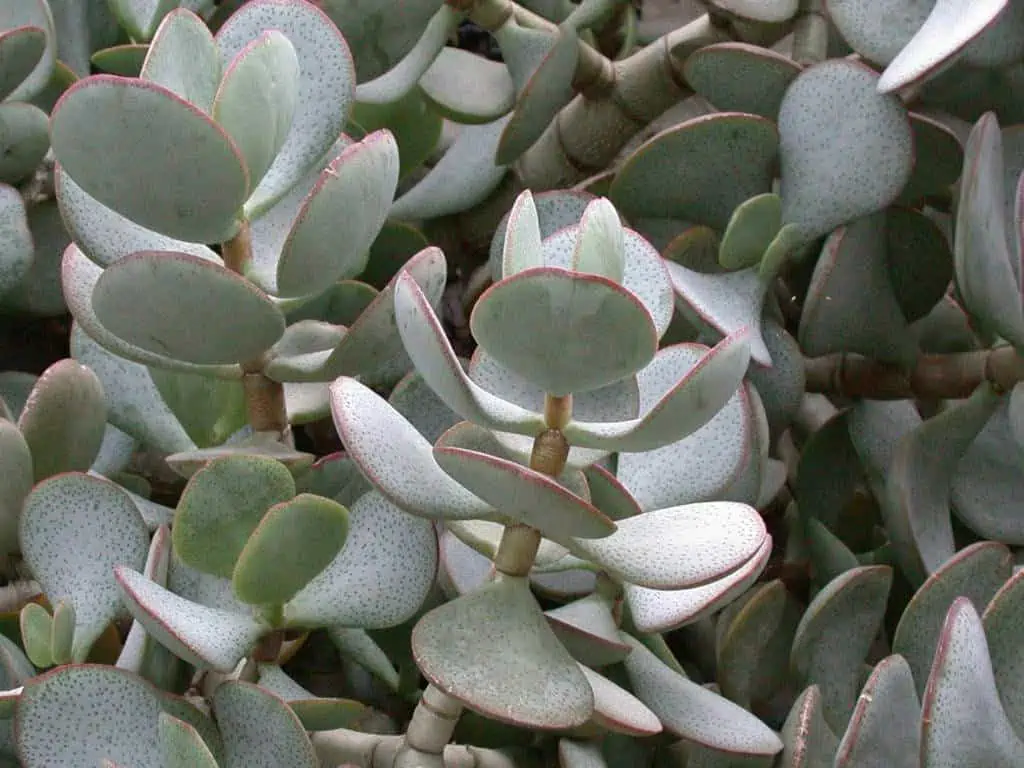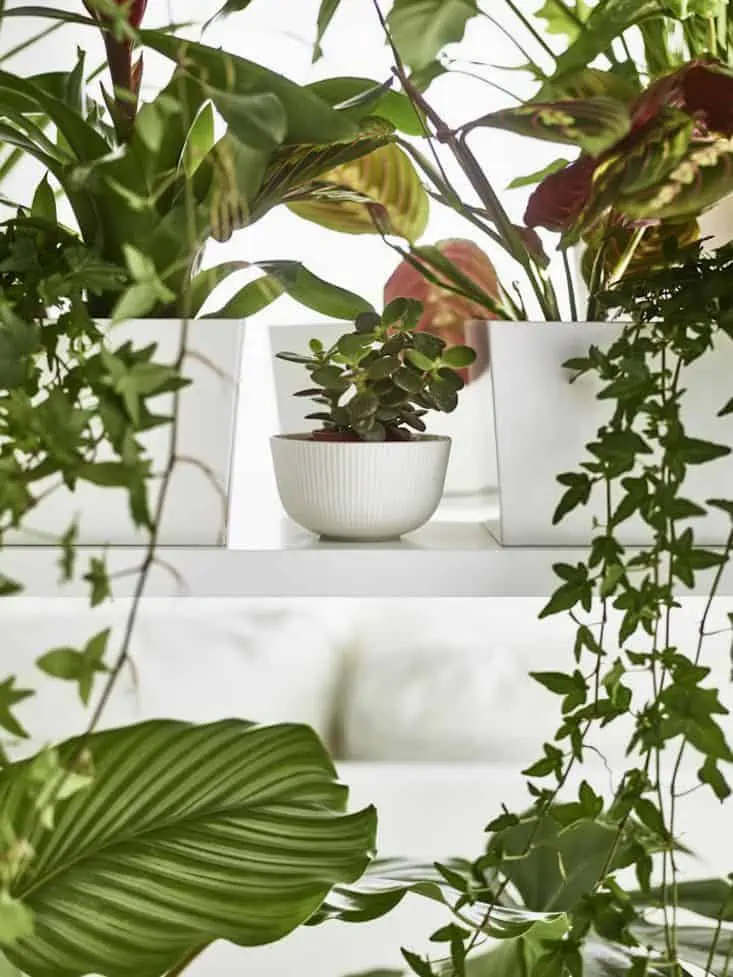One of the most popular interior decor trends is all about adding greenery to your space. Any kind of indoor plant, from succulents to bonsai, can create a natural and fresh vibe for your interiors. Indoor plants are not just a treat for your eyes, but they purify the air and promote calmness. There is an infinite variety when it comes to indoor plants. However, some plants are easier to maintain than others. The jade plant is one of the most favoured indoor plants. Jade is a beautiful plant variety with few species that blossom into tiny pink flowers. It is succulent and therefore very easy to maintain. However, if you are a new plant parent, the easiest plants can be harder than expected. To save you the trouble, we have put together a holistic guide for jade plant benefits, care, propagation, types, and also decor display ideas.
The benefits of the jade plant

Image Source: Love to know
Easy to maintain: Since it is succulent, it does not require a lot of water or too much sunlight. Jade is a slow-growing plant; thus, it doesn’t need to be repotted for a long time. This plant can live in neglect for long periods. It can thrive in both direct and indirect sunlight.
Improves air quality: Air pollution is showing its effect everywhere; from indoors to outdoors. The air quality inside the homes is often as toxic as it is outside. Adding jade plants to your interiors can keep the “sick building syndrome” away. Jade is one of the air-purifying indoor plants. It helps in reducing the chances of allergies.
Medicinal qualities: For many generations in Chinese and African cultures, jade has been used as a medicinal plant. Jade has proven to be beneficial for skin warts, diabetes, and overall body blood circulation. It is still consumed as tea for its stress-relieving qualities.
Symbol of luck and prosperity: In Asian cultures, the jade tree is associated with fortune and prosperity. According to the ancient Chinese text – Feng Shui, jade promotes consistency in behaviour as it is an evergreen plant. Moreover, the jade plant makes for a good gift option for any housewarming party, since it brings wealth and prosperity.
Appealing to the eyes: Jade is a compact plant. Thus, it blends well with any type of interior. All the different species of jade plant are pleasant in appearance, with beautiful green leaves, flowers, sometimes with a hint of pink in leaves. Jade plant flowers are as beautiful as cherry blossoms and can add so much positivity to the room with their tiny flowers.
How to take care of the jade plant?

Image Source: Kellogg garden products
We all know how easy it is to take care of a succulent. However, total ignorance of these low-maintenance plants can be fatal. Jade plants are very sensitive to overwatering, but if given proper attention, the jade plants can grow beautifully without much effort. Below are the major care points for the jade plant.
Watering
Watering is one of the most important issues for jade plants. Succulents need minimum watering to survive, and more often than not, they die due to overwatering. The leaves of jade act as a water reservoir, and overwatering can make them mushy. The ideal watering cycle for jade is 7 to 14 days. Check the soil before watering. If it’s completely dry, take it as a cue to water.
Sunlight
Jade plants are best friends with the sun. If your plant is in the growing stage, it is advised to keep it in direct sunlight for the best results. Jade plants require 5–6 hours of sunlight but do not keep young plants in spots exposed to harsh rays. Direct, harsh rays from the sun can scratch the young leaves of jade. The ideal spot for jade is on window sills or balconies. Only with appropriate sunlight can jade plants blossom into tiny pink flowers.
Fertilizer
Almost all type of jade plant does not require much attention apart from occasional watering, but if you want healthier growth for your jade, controlled fertilisation can do the job. The use of fertiliser with less nitrogen content may benefit the young jade plants and mild all-purpose organic fertiliser for mature plants. Jade plants are scarce feeders, so only use half-strength fertilizer every two months in the growing season.
Repotting
The jade plant is a slow-growing plant, so it does not require repotting for a long time. An occasional repotting may be required depending on the type of jade plant. Every 2-3 years for young jades and every 4-5 years for mature ones. Always upgrade the pot or planter in terms of size, and it is advised to do the repotting during the onset of spring for best results and quick adaptation.
Pests
Care against pests for any indoor plant is a must. Jade plants are susceptible to mealybugs, spider mites, scale, or aphids. The cure to keep the pest at bay is to wash the foliage and dry it with cotton pads. If needed, rubbing alcohol on infected jade plant parts may also benefit.
Propagation of the jade plant

Image Source: Rural sprout
Propagation of jade from a cutting
- Take a cutting of 3-4 inches from a healthy, mature jade plant.
- Store the cutting in a clean and dry place for a few days until the end of the cutting is dry and scrubby.
- Dip or rub rooting hormone powder over the cutting end that you will plant in the soil. (This step is optional, but if you want fast rooting, then you should definitely try it!)
- Now, plant the end dipped in rooting hormone powder in a pot of half soil and half vermiculite.
- Damp the soil and vermiculite mixture with water.
- The cutting takes a few weeks to root, so wait patiently for the rooting to start and then take care of the cutting as you would normally take care of a jade plant.
Propagating jade from leaves

Image Source: Rural sprout
- Take a leaf out with the leaf stem intact from a healthy, pest-free mature jade plant.
- Store the leaf in a dry and clean place for a few days until the end of the cutting is dry and scrubby.
- Again, you can dip the leaf stem in rooting hormone powder for speedy results.
- Prepare a pot with a mixture of half soil and half vermiculite. Next, place the leaf cuttings on top of the soil. Do not bury it; just place the leaf stem in close contact with the soil.
- Now, dampen the mixture lightly.
- Keep the pot in a bright and dry spot with direct sunlight. You may use the misting process occasionally to dampen the top of the soil to promote growth.
- Once the leaf starts rooting, you may follow the care steps for a traditional jade plant.
Jade plant troubleshooting

Image Source: Greenkosh.com
Yellow leaves
If you notice a bunch of yellow or pale-coloured leaves on your jade plant, it indicates the plant’s overgrowth. To fix the issue, you need to cut the overgrowth to maintain a healthy plant or consider repotting.
Squishy leaves
Squishy plant leaves or stems suggest issues of overwatering or rotting roots. To avoid this issue, ensure the plant pot drainage is proper and place the pot in a dry and bright place for quick recovery.
Leaves dropping
Dropping leaves at a frequent rate may suggest that your jade needs more sunlight. To solve the issue, place the jade pot in a spot that experiences more brightness. If the leaves that are falling are old, dried ones, along with leggy growth, your plant needs to be in a spot that experiences indirect sunlight.
Mushy plant tissue
Mushy or browning plant tissue suggests bacterial rot. This infection in the plant may appear to be limited to one area, but it has the potential to quickly spread to other areas. The best solution to avoid infecting all other plants is to get rid of the infected plant.
White spots on leaves
The white or pale spots on the jade leaves indicate an excess of salt in the soil or pests. It is best to determine the issue first and then treat it accordingly.
Spots on foliage
Spots on the foliage suggest that the plant is infected with a fungus. The best way to get rid of the problem is to use a fungicide and place the plant in a dry and well-ventilated spot for a speedy recovery.
Types of jade plants
Inspiration for a jade plant display
-
Image Source: Cactusway
-
Image Source: Sprouted in soil
-
Image Source: Petal republic
-
Image Source: Sara Toufali
-
Image Source: Garden tabs
-
Image Source: Fernsandpetals
-
Image Source: Houseplant central
-
Image Source: blog.mytastefulspace.com
-
Image Source: muckout.de
-
Image Source: Gardeninsta
-
Image Source: redecaitop.com
Conclusion
Jade is a beautiful succulent that is perfect for adding greenery to your interiors. The jade plant is not just beautiful but also possesses various benefits that make it a common choice for a house plant. This low-maintenance plant is the perfect pick for first-time plant parents. The compact size and different types of the jade plant allow you the liberty to decorate and display it in a variety of ways. Apart from the decor factor, jade is a great choice of gift for a housewarming or to wish someone a healthy recovery. So, now is the time to add jade plants to your interiors and welcome positivity, prosperity, greenery and maybe some tiny flowers!
*The feature image used in the article is from Love to know (Sally Painter)














































